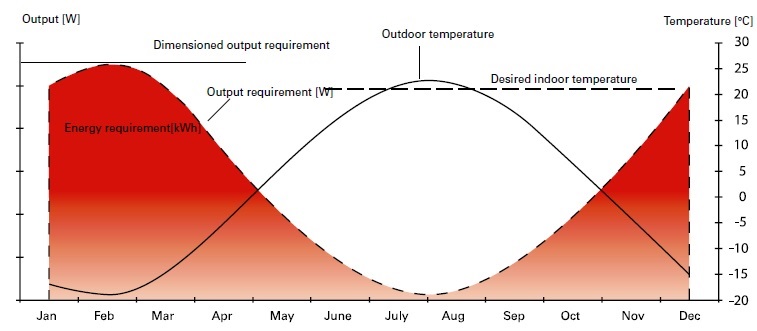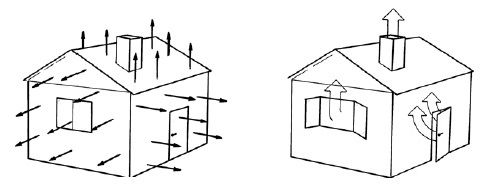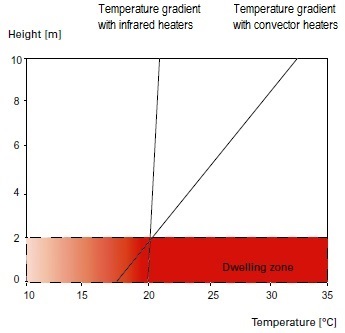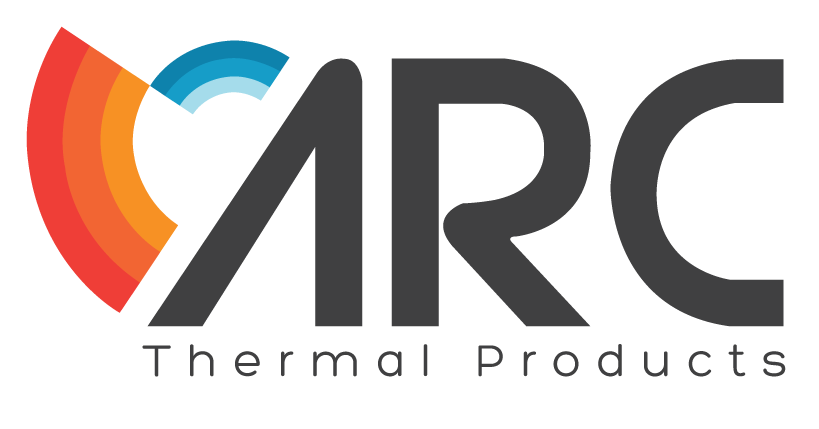Building heating requirements
The need for heating large spaces depends on the temperature difference between the room air and outdoor air.
The temperature of the outdoor temperature varies with the seasons and location, while the air temperature within the room should be maintained at a balanced and comfortable level. The energy requirement for a building is therefore the amount of energy consumed during a year (coloured area in the diagram below) to maintain the desired indoor temperature.

Heat loss in buildings
Energy losses in a building can be divided into two categories:
- transmission losses via building structures (roof, walls, etc.)
- ventilation losses through ventilation, leakage and openings

The size of transmission losses varies according to the areas of the building parts and insulation. The losses are proportional to the temperature differences between indoor and outdoor air.
Ventilation losses in a building are either mechanical or natural/involuntary. Mechanical ventilation usually consists of a supply and exhaust air unit that makes heat reclamation possible. Natural and involuntary ventilation consists of thermal currents causing warm air to rise and leak through openings and unsealed areas.
Types of heating system
When heating large spaces with high ceilings the heating system must cover all energy losses, both from transmission and ventilation. Three main types of heating are used in the UK:
- Infrared heating – transfers heat to surfaces and objects without warming the air on the way. Surfaces are heated and then in turn heat the air within the room. People experience the direct effect of infrared heat as warmth. The room feels comfortably heated even if the air temperature is relatively low. Infrared heating also prevents overheated air gathering under the ceiling. The minimal temperature gradient between floor and ceiling as well as the lower air temperature contributes to large energy savings. Infrared heat effectively counteracts cold radiation and cold draughts for example from large roller shutter doors and windows.
- Air heating – uses warm air to cover heat losses from the building. The warm air cools along the outer walls, due to transmission losses. Therefore, the supply air temperature must be higher than the desired room temperature. As the heated air is lighter and rises in the room, large temperature differences occur between the ceiling and the floor. At times, it may be necessary to equalise the differences with ceiling fans.
- Convective heating – transfers heat to the room by warming the air as it passes the hot surface of a radiator or convector. The air-flow past the radiator or convector is maintained by convection currents. The warmed air rises and is constantly replaced by cooler air. For example, cold draughts from windows are effectively counteracted by the rising stream of warm air if the heat source is placed under the window, as is traditionally the case.
Reducing heat loss and improving energy efficiency
Improved insulation of a building naturally reduces heat losses and increases energy savings but there are other methods of reducing heating costs as well.
Equalizing temperature differences

Warm air is lighter than cold air and is gathered in the highest spot inside a building. Vertical temperature differences between floor and ceiling occur. The temperature gradient (°C/m) is a measure of the temperature rise per metre of height and varies depending on the heating system and the season. In rooms with high ceilings (e.g. village halls, churches, sports centres, warehousing and factories) the temperature difference between the dwelling zone and the ceiling is often significant, between 10-15°C. Equalizing the temperature differences can reduce heat losses by as much as 30% while making optimal use of the heat.
Infrared heaters
Heating large spaces with ceiling mounted infrared heaters is a form of indirect heating. The heat develops when the infrared waves hit a thermal mass such as floors, walls, machines, people, etc. The energy is absorbed and the warmed surfaces then heat the air in the dwelling zone. As a result, the temperature difference between ceiling and floor is minimal.
Lower the indoor temperature
Another method of saving energy when heating in village halls, for example, is to lower the indoor temperature. However, this must be done without sacrificing the comfort.
Lower air temperatures

By using infrared heaters, the air temperature in a room can be lowered by a few degrees (from 21°C to 18°C) while still maintaining the same level of thermal comfort or ‘operative temperature’. A reduction of the temperature by 1°C results in energy savings of around 5%. Operative temperatures are those temperatures which human beings feel. They are the sum of the air temperature and radiation temperatures. All objects provide radiant temperature changes. Cold surfaces like a cold wall or window cause a subtraction and warm surfaces an addition.
Low temperature gradient

Heating large spaces with high ceilings using infrared reduces the vertical temperature gradient between floor and ceiling. The heat develops when the rays meet surfaces such as floors, walls, machines, etc. The surfaces in turn heat the air in the dwelling zone. The temperature differences between the ceiling and the floor therefore become very small and overheating is minimal. In buildings with high ceilings like warehouses, factories, village halls, churches and sports centres substantial energy savings are obtained compared to conventional heating systems where most of the energy consumed is used to overheat the space above the ‘dwelling zone.
The temperature gradient (temperature rise per metre of height) is very low for infrared heaters – approximately 0.3°C/m. In contrast, warm air heating or heating with conventional radiators causes significantly greater temperature differences per metre of height with temperature gradients of 2.5 and 1.7 °C/m respectively.
Zone and spot heating
With warehouse heating and industrial heating infrared can be used to create different zones with varying temperatures. The entire building does not have to have the same high temperature, which in turn, reduces the overall energy requirement. Even personal comfort levels may dictate the need for different work stations to have different temperatures. Spot heating can be thought of in the same way as spotlighting where the heat is delivered exactly where required.
Utilise precise heating controls
Precise control of a heating system leads to greater energy savings and better thermal comfort for the occupants. Infrared heating is particularly responsive, as the heaters start to heat and benefit the occupants in the room as soon as they are switched on. This makes infrared the perfect technology to use in combination with programmable thermostats, timers and presence detectors. A well designed and controlled system ensures that the infrared heating is only used when necessary.














